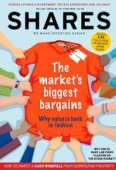Archived article
Please note that tax, investment, pension and ISA rules can change and the information and any views contained in this article may now be inaccurate.
The market’s biggest bargains: Why value is back in fashion

Snaring a bargain can be very satisfying in any aspect of life and when it comes to the stock market increasingly lucrative too.
There are signs that value is starting to come back into fashion following several years when investors were focused on companies delivering growth with little regard for valuation.
Growth investors look to snaffle out stocks where there is potential for significant expansion. A growth stock is usually defined as a company whose earnings are expected to grow at an above average rate either for its industry or the overall market.
A growth investor will buy such a stock even if it appears to be expensive based on metrics such as the price-to-earnings (PE) ratio.
Value investing is often seen as the reverse of growth investing and places the emphasis on finding assets which trade on lowly valuations, in the hope that the valuation will eventually revert back to more normal levels.
VALUE IS PERFORMING WELL AGAIN
Philip Wolstencroft, fund manager of Artemis European Growth (GB0006600844), comments: ‘Over the past 100 years or so, cheap stocks have tended to outperform the market in two years out of three. In the past decade the proportion has been nearer two out of 10.
‘The reasons for this are many fold; essentially cheap stocks have delivered poor growth since the financial crisis and so have delivered poor share price performance. This appears to be changing. Cheap stocks are now delivering superior growth.’
Wolstencroft says numerous fund managers are loaded up with growth stocks at a time when not only are they expensive, but are delivering poor relative growth and so are underperforming.
Matthew Jennings, investment director at fund provider Fidelity, says investors should not get too hung up on any particular style of investing. ‘We should look beyond these labels, towards rigorous and differentiated fundamental research and performance driven more by stock selection than by style bias,’ he says.
LOOK BEYOND THE METRICS
We agree with this assessment and the selections overleaf aren’t solely picked because they look cheap on certain metrics like price-to-earnings and net asset value per share. They have also been subjected to close analysis by the Shares team and have clearly identifiable catalysts which can drive the shares higher.
Inchcape (INCH) 738.5p
A prospective PE of 11.3 for Inchcape, based on J.P. Morgan Cazenove’s 65.1p earnings per share estimate for 2018, appears grudging for a multi-brand car distributor whose global diversification and scale are under-appreciated. J.P. Morgan Cazenove’s 920p price target implies 25% upside for the share price over the next year.
So why are the shares cheap? Testing market conditions in certain regions are weighing on the stock. While the higher margin distribution arm is motoring, Inchcape’s retail business is challenged by new car margin pressures in the UK and Australia and a cyclical downturn in the Singapore market.
Deutsche Bank also expects flat 2018 profits in sterling from Inchcape, however it is continuing to motor in emerging markets. Inchcape has also been swept up in the souring of sentiment toward the UK domestic automotive retail sector, unfairly so given its profit bias to emerging markets.
Myriad strengths include long-established partnerships with high-end car brands, among them BMW, Aston Martin and Mercedes-Benz, and entrenched distribution in developing markets, which have combined to carve out a wide economic moat.
Earnings are diversified across five continents and revenue streams span new and used car sales, higher margin aftersales, spare parts, finance and insurance products.
A better second half of 2018, supported by easier comparatives, could act as potential re-rating catalyst, so long as growth trends in challenged markets improve.
Furthermore, a solid balance sheet and strong cash generation will enable Inchcape to capitalise on a healthy acquisitions pipeline, while continuing to fund a progressive dividend and a new £100m share buyback. (JC)
International Consolidated Airlines (IAG) 705.4p
The British Airways owner still looks cheap despite a decent run for the share price since October 2016.
The airline trades on a mere 7.1 times forecast earnings compared to its peers which have an average PE of 12.67, including rivals such as Ryanair (RYA) and EasyJet (EZJ). IAG also has an attractive 9.6% free cash flow yield.
While the airline sector is starting to recover from an intense price war, analysts have been wary of a range of risks including rising fuel costs and the impact of Brexit negotiations.
Although IAG’s most recent full year results, published in February, slightly missed expectations at the operating profit level, a subsequent update shows a business in good health.
Its first quarter results showed a 75% jump in operating profit to €280m, smashing consensus expectations of €206m and helped by favourable exchange rates, the timing of Easter and a continuation of improvements that began in 2017. That news, plus a new €500m share buyback, has helped to strengthen the share price.
The airline is trying to acquire embattled rival Norwegian Air Shuttle after buying a 4.61% stake, but has already had two ‘undervalued’ takeover offers rebuffed.
Norwegian runs ultra-cheap US flights from Europe but doesn’t make any money and is drowning in debt. IAG’s interest in the business looks like a mixture of defending its own transatlantic operations from low cost competition, plus an opportunistic move while Norwegian’s own valuation is very cheap. (LMJ)
Barclays (BARC) 203.95p
Put simply, Barclays is one of the cheapest UK banks. According to data from Reuters, it trades on a price-to-book ratio of just 0.6-times, quite a bit below its peer group average of 0.9-times. However its first quarter results to 31 March go some way in explaining the relative cheapness of the financial institution, having recorded a pre-tax loss of £236m.
This loss was largely due to the cost of settling a historic case with the US Department of Justice over the mis-selling of mortgage-backed securities. Barclays had to pay the US regulator £1.4bn to settle the matter and a further £400m in relation to ongoing Payment Protection Insurance claims.
However, if these misconduct charges are stripped out, the bank’s pre-tax profits actually increased by 1% to £1.73bn. This was driven by a 45% improvement in impairment charges and a 6% reduction in operating costs.
A key sign of a bank’s profitability is its return on tangible equity (ROTE); last year Barclays posted a worst in class 1.1%. However, for the first quarter of 2018 the bank’s ROTE was an impressive 11% when exceptional items such as litigation charges are stripped out.
Given that Barclays has now settled with the Department of Justice the bank’s return to profitability should continue and its shares could re-rate.
However, you should note activist investor Edward Bramson recently appeared on the shareholder register with a 4.9% stake held via investment vehicle Sherborne Investors (SIGC).
Little is known about his intentions but media reports suggest his presence is unwelcome given Barclays’ management are focused on reviving the business and could do without the distraction of a shareholder who may push for big M&A deals.
As such, you should treat this stock as fairly high risk although you do get some compensation in the form of a dividend yield in the region of 3.2% based on current year forecasts, rising to 4.1% in 2019 and 4.6% in 2020.
Those figures are less generous than the yields you could get from HSBC (HSBA) and Lloyds (LLOY), although they are arguably less risky investments (relative to the broader sector) and so the potential rewards may not be as high as from Barclays if the latter can rejuvenate its business. (DS)
Strix (KETL:AIM) 145p
On price-to-earnings metrics Strix trades at a rough 50% discount to peers, according to Reuters’ data. Based on 2018 earnings estimates, Strix trades on a PE of 10.6, falling to 9.8-times in 2019.
The company designs and makes clever controls and safety devices fitted on many of the 70m kettles sold worldwide each year. They appear on brands you should recognise including products from Bosch, DeLonghi, Kenwood, Russell Hobbs and more.
Strix’s intellectual property-protected devices are widely considered best-in-class, demonstrated by long-term relationships with over 400 brands and retailers. It claims to have about 40% of global market share.
There are cheaper copycat devices available but many mainstream volume makers stick with Strix and pay more because they trust the equipment and are likely to avoid expensive product recalls. That should help Strix defend 30% to 33% operating profit margins.
Yet the wider kettle market is also growing faster than before, largely because more affluent Chinese people can afford household labour-saving luxuries. Between 2012 and 2017 the market averaged 5.6% growth a year but this pace is expected to accelerate to 7%-plus through to 2020, say analysts.
Strix has generated over £30m of adjusted earnings before interest, tax, depreciation and amortisation (EBITDA) in each of the last 10 years, and is very cash generative. That helps to fund generous dividends with the shares currently yielding 5.4%, far higher than the 3.6% FTSE All-Share average. (SF)
Important information:
These articles are provided by Shares magazine which is published by AJ Bell Media, a part of AJ Bell. Shares is not written by AJ Bell.
Shares is provided for your general information and use and is not a personal recommendation to invest. It is not intended to be relied upon by you in making or not making any investment decisions. The investments referred to in these articles will not be suitable for all investors. If in doubt please seek appropriate independent financial advice.
Investors acting on the information in these articles do so at their own risk and AJ Bell Media and its staff do not accept liability for losses suffered by investors as a result of their investment decisions.
Issue contents
Big News
- BT in charm offensive to get investors back onside
- Markets are climbing the ‘wall of worry’
- Battle for control at Stobart and Petropavlovsk
- What does the Government sale of RBS stake mean for investors?
- Why Hotel Chocolat continues to be a sweet investment
- Bodycote boom time raises the fear of inevitable bust

 magazine
magazine












